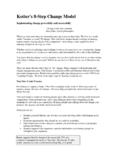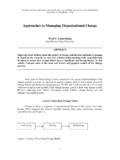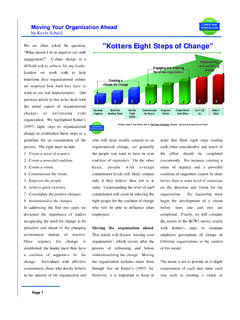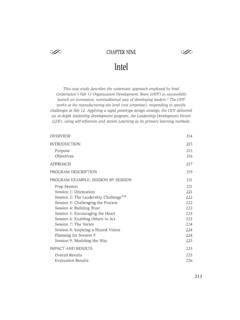Transcription of The Concept of Emotional Intelligence - …
1 Samatvam Academy, M-1/31, DLF City Phase II, Gurgaon 122 002, India. The Concept of Emotional Intelligence by Dr. Sunil Maheshwari and Mr. Aseem Nath Tripathi Intelligence is a general descriptive term referring to a hierarchy of mental abilities, from simple perceptual processes and information processing to higher and more general forms of problem solving (Carroll, 1993). Until now the term " Intelligence " has been limited largely to certain kinds of problem-solving involving language and logic. However, human beings are able to deal with numerous kinds of content besides words, numbers, and logical relations -- for example, space, music, the psyches of other human beings.
2 Thus, in the present decade, researchers have explored the possibility that intelligences are a more diverse and looser confederation of abilities than once was thought. One evident factor in the rethinking of Intelligence is the perspective introduced by scholars who are not psychologists. Anthropologists have commented that some cultures do not even have a Concept called Intelligence , and others define Intelligence in terms of traits such as obedience, good listening skills, or moral fiber (Gardner, 1999). Neuroscientists are skeptical that the highly differentiated and modular structure of the brain is consistent with a unitary form of Intelligence . By the end of the twentieth century, it was amply evident that mental functions are highly interconnected.
3 Most of one s mental processes, from colour perception to self-insight, potentially involve and activate both emotion and Intelligence (LeDoux 2000). Yet, the tension between exclusively cognitive views of what it means to be intelligent and broader views that include a positive role for emotions in Intelligence can be traced back many centuries. The Stoic philosophers of Ancient Greece focused on virtue, and viewed emotion as too individualistic and self-absorbed to be a reliable guide for insight and wisdom. Later, the Romantic movement of eighteenth-century Europe stressed how intuition and empathy, rooted in emotion, could provide insights that were unavailable through logic alone (Reddy, 2001).
4 The Concept of Emotional Intelligence (EI) offers a new way of looking at the debate - that people can reason about emotions and use emotions to assist reasoning. 1. The Definition and Scope of Emotional Intelligence Emotional Intelligence (EI) is historically defined as the ability to carry out accurate reasoning focused on emotions and the ability to use emotions and Emotional knowledge to enhance thought (Mayer & Salovey, 1997). Its primary focus has to do with reasoning about emotions and the use of emotions to enhance thought. Thus, EI represents abilities that join Intelligence and emotion to enhance thought. Samatvam Academy, M-1/31, DLF City Phase II, Gurgaon 122 002, India.
5 Many commentators suppose that EI derives from the broader construct of social Intelligence ( Bar-On, 2000). Contemporary perspectives on social Intelligence have their origins in Thorndike s influential, tripartite division of Intelligence into the following broad classes: (a) abstract-scholastic Intelligence : the ability to understand and manage ideas, (b) mechanical-visuo-spatial Intelligence : the ability to understand and manipulate concrete objects; and (c) social (practical) Intelligence : the ability to understand and manage people and act wisely in social contexts. However, despite considerable interest and numerous attempts to define and measure social Intelligence over the past eight decades, these attempts have proved problematic (Kihlstrom & Cantor, 2000).
6 The inability to discriminate between general and social Intelligence , coupled with difficulties in selecting external criteria against which to validate experimental scales, led to a decline in research focusing on social Intelligence as a distinct intellectual entity, until the recent upsurge of interest in EI. Approaches to Emotional Intelligence Theoretical approaches to EI broadly divide into two categories. Specific-Ability approaches examine relatively discrete mental abilities that process Emotional information, while Integrative-Model approaches describe overarching frameworks of mental abilities that combine skills from multiple EI areas.
7 A third approach to EI is often referred to as a Mixed Model approach because of the mixed qualities that such models target. Specific-ability approaches focus on a particular skill or skills that can be considered fundamental to EI. Some specific-ability models address the ways in which emotions facilitate thinking. For example, emotions may prioritize thinking (Mandler 1975) or allow people to be better decision makers (Lyubomirsky et al. 2005). A person who responds emotionally to important issues will attend to more crucial aspects of his or her life. By contrast, if the person is constantly frustrated, say, by her subordinate s minor clerical errors, then broader concerns that are more important may not be addressed (Parrott 2002).
8 In addition, certain specific emotions can foster given types of thinking. For example, positive emotions promote greater creativity in some contexts (Amabile et al. 2005, Averill & Nunley 1992, Isen 2001, Lyubomirsky et al., 2005). Part of Emotional facilitation is to know how to include emotions in, and exclude emotions from, thought. Another set of specific-ability models concerns Emotional reasoning and understanding. For example, emotion-appraisal researchers have developed decision rules for matching a given emotion to the class of situations that has elicited it. For example, if a person experiences fear, it is likely that he or she is facing a situation that is threatening, raising thoughts of bad things happening, and elicits a need to escape (Scherer et al.)
9 , 2001). Related to such appraisals are the accurate labeling and categorization of feelings (Innes-Ker & Niedenthal, 2002). Theorists have argued that accurate appraisal may be a hallmark of emotionally intelligent responses (MacCann et al., 2004). If a person s appraisal process is awry, then he or she may misunderstand an event or its consequences and react inappropriately. Samatvam Academy, M-1/31, DLF City Phase II, Gurgaon 122 002, India. Yet another relevant ability area concerns Emotional self-management. This area grew out of clinical findings that one s emotionality could become more positive by reframing perceptions of situations (Beck et al., 1979), as well as from the idea that individuals often exert considerable Emotional self-control when at work (Hochschild, 1983).
10 On the other hand, the key element in integrative models of EI is the joining of several specific abilities to obtain an overall sense of EI. The Four-Branch Model views Emotional Intelligence as joining abilities from four areas: (a) accurately perceiving emotion, (b) using emotions to facilitate thought, (c) understanding emotion, and (d) managing emotion (Mayer et al. 2003). Each of these areas is viewed as developing from early childhood onward. For example, in perceiving emotion, a person s ability to recognize basic emotions in faces is likely to precede the ability to detect the faking of Emotional expressions (Mayer & Salovey 1997). As skills grow in one area ( , perceiving emotions), so will they grow in other areas (such as understanding and regulating emotions).









